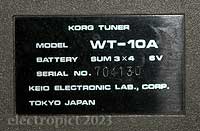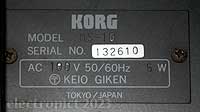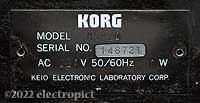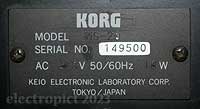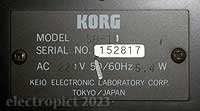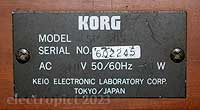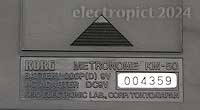I was wondering about MS‑20 serial numbers and identifying characteristics. One thing led to another and, well, I started to compile this page. It grew substantially, and the actual MS‑20 details are now on a new page:
Korg MS‑20 Serials & Characteristics
There is also a more detailed investigation of one particular serial number:
Twynthesisers
Korg used a variety of serial number systems up to about 1984, when the last product catalogue I’ve read came out [1]; the tables here attempt to make sense of them. Introduction years given and chronological order are a bit approximate as not all sources are reliably precise. Some serial numbers are linked to sources (mostly Matrixsynth (MS)); the others are mostly from online ephemera. [2] [3] Numbers suffixed P are devices I have personally examined. Some instruments have appeared online repeatedly; all quasi-permanent appearances found are listed. Where an item is relisted on an auction site by the same seller it will normally be regarded as one appearance, unless additional photos etc. are given. “ⓘ” symbols indicate tooltips with additional information, usually dates or reliability qualifications.
These pages will usually be updated as and when I see more numbers. (Additions with durable online sources or pictures welcome. Current total examples known (including MS-20s): 3,166)
Please note: Examples are noted here in an attempt to find patterns in serial numbers. The presence on these pages of a serial number found on a sales site does not imply anything about the honesty of the seller; indeed there have been a number of cases where the sales seem unlikely to be genuine, and the purported sellers may not even be in the country they claim to be selling in. (Alternatively images may be reused by different sellers who are too lazy to take their own shots.)
There are three main groups of models with different types of serial numbers, (as at end 2024) split into individual pages:
- Year-based and Other Numbers (c.1966–1981)
Donca Matic Rockmate, Mini Pops Doncamatic, Doncamatic Mini Pops 5, Mini Pops 7, Mini Pops 3, Mini Pops 20 S, JR‑5, Mini Pops Junior, Synthesizer Traveler, Donca Matic Stage Man, VCF, Mr.Multi, K‑1, K‑2, K‑3, RT‑10, WT‑10A, 900PS, SB‑100, Mini Pops 35, Mini Pops 120(P/W), Mini Pops SR‑120, K‑4, K‑5, KORG‑770, KA‑180, M‑500, M‑500SP, PS‑3010, PS‑3100, PS‑3300, Quartz - Model Numbers (1977–c.1983)
EM‑570, SE‑500, GT‑6, MS‑10, SQ‑10, VC‑10, MS‑02, MS‑03, MS‑50, SE‑300, PS‑3200, WT‑12, Λ, Σ, KR‑55, KR‑33, X‑911, Δ, PK‑13, SD‑400, SD‑200, WT‑3, CX‑3, Trident (I), BX‑3, LP‑10, Mono/Poly, PolySix, KR‑55B, BPX‑3, Trident II, EPS‑1, Micro-Six, SDD‑3000, KPR‑77, Symphonic Piano 80, Symphonic Piano 80S, Poly‑61, SAS‑20 - Just Numbers (1983–)
AT‑12, GT‑60X, KM‑50, KMX‑8, MM‑25, PME‑40X, PSS‑50, Poly‑61m, Poly‑800, CPG‑01, CPK‑01, CPS‑01, DDM‑110, DDM‑220, KMS‑30, KMT‑60, EX‑800, SDD‑1000
Known Unknowns
No serial numbers visible on pictures I’ve seen of MS‑01s, MS‑04s, FK‑3s, FK‑4s, and FK‑5s. I have also examined a KVP‑001 pedal, and the slightly later EXP‑2 and KVP‑002, and found none. This may be typical for Korg pedals of the time. An exception is the PME‑40X — and its modules, which also seem to be “just numbers”, but I haven’t been taking a note of them.
(Some internal photographs of MS‑04, FK‑2, and FK‑4 pedals do however show what may be 4-digit (yymm?) batch numbers.)
Other models I’ve seen no numbers for include: KA‑180M, PS‑3040, PS‑3050, PS‑3060, Mini Pops 45, WT‑13, SP‑2035 [4].
As a general caveat regarding distribution of these serial numbers, it should be borne in mind that there is an obvious sampling bias, on the basis that the websites I can keep track of are English-language ones; while this includes some results from Japan and occasionally various parts of Europe, the bulk of these numbers are found either on eBay.uk or on Matrixsynth, which predominantly obtains results from eBay.us. Therefore units sold in non-English national markets are likely to be underrepresented. I have no good information regarding original sales proportions in non-English markets, but there seem to be very few results from, for example, Hindi, Spanish, or Swahili markets. It may indeed be that sales in these areas were quite limited in c.1965–1984, but that doesn’t mean they weren’t there at all, and more significantly it doesn’t mean that distinctive serial number formats might not have been used, which are not identified in these results to date.
PEX
Some things I’ve examined personally.
Appendix: Collisions
All duplications (and currently triplications) of serial numbers between models found on these pages. (n.b. In instances in the tables where digits are given as unclear, they will not appear in this table. Where there were multiple instances of the same model with one serial number this is not counted here either.)
| number | models | ||
|---|---|---|---|
| 0066 | K‑1 | Σ | |
| 000560 | KMS‑30 | EX‑800 | |
| 001372 | KMX‑8 | EX‑800 | |
| 005117 | DDM‑220 | EX‑800 | |
| 141219 | GT‑60X | MS‑20 | |
| 702650 | Mini Pops 3 | Poly‑61 | |
| 750039 | VCF | 900PS | |
| 760051 | K‑3 | KORG‑770 | |
| 760093 | K‑3 | K‑5 | |
| 760322 | K‑2 | K‑3 | |
| 770004 | K‑3 | Mini Pops SR‑120 | K‑5 |
| 770006 | K‑5 | KORG‑770 | |
| 770024 | VCF | K‑3 | |
| 770041 | Mini Pops Junior | K‑3 | K‑5 |
| 770071 | K‑3 | Mini Pops 35 | |
| 770073 | K‑2 | KORG‑770 | |
| 770167 | K‑4 | KORG‑770 | |
| 770172 | VCF | 900PS | |
| 770203 | 900PS | K‑4 | M‑500 |
| 770220 | K‑3 | KORG‑770 | |
| 770222 | K‑5 | KORG‑770 | |
| 770325 | Mr.Multi | KORG‑770 | |
| 770410 | K‑5 | KORG‑770 | |
| 770441 | K‑4 | KORG‑770 | |
| 770474 | K‑4 | KORG‑770 | |
| 770657 | K‑4 | KORG‑770 | |
| 771201 | M‑500 | PS‑3300 | |
| 780070 | SB‑100 | K‑5 | |
(This table is automatically generated and may be updated without notice.)
Thus far the majority of collisions occur because the same early date-based serial numbers could be applied to any model. There are also some which are duplicates of the later type. At February 2025 one collision between a tuner and a model-number type has been found, but it implies that there may be more.
Comment or Question about this page? write
Notes
- After 1984 there seems to be an increasingly numerous and indistinct range of plastic boxes and serial numbers. I don’t feel like I have time to spend on them. ↖
- Some sources are given as year-month, eBay, country of sale, but it should be noted that occasionally the location of sale items is not given in eBay listings, only the seller’s nominal business location. In some instances the instrument and even the actual seller were elsewhere, perhaps in a different country. As I usually only check the UK eBay it’s the default. ↖
- Some sources at reverb.com were previously linked but these pages seem no longer available at 2024-05-16 so I won’t be giving links there in future. ↖
- I suspect these are the 10- block on grounds of proximity to the EM‑570. ↖
Article text ©2022–2025 Electropict  .
.
Click images for individual licences.

